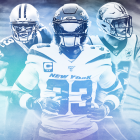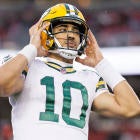The email came from our editors last week:
Hi Dubes,
I want to build a 32-man roster where you have to use one guy from each NFL team. So, basically MLB All-Star Game style. In order to get to 32, I've included three coaches (HC, OC, DC), three special teams players (K, P, RET) and a few sub package guys on offense and defense, like a second TE, a slot CB, a nose tackle, a fourth WR/gadget type offensive player, etc.
So, that's why we're here. We're going to try to build the best possible roster using one representative and only one representative from each of the 32 NFL teams. Think of it as a "survivor squad," where just like in survivor pool competition, once you use a team once, you can't use them again.
In an exercise like this, it's important to know exactly how you want to build your team. To compete in the modern NFL, you have to recognize that the passing game is king, and build the roster accordingly. So, in all toss-up decisions, the tiebreaker was whichever would help our offense throw the ball and our defense stop the opposing offense from doing the same.
I joined Will Brinson on the Pick Six Podcast to break down my Survivor Squad and defend my selections; give it a listen below and be sure to subscribe on your favorite podcast platform.
We also wanted our team to be as flexible as possible -- especially on defense, where the ability to disguise what you're doing and have players fill multiple roles depending on the snap is paramount. So, pass-catching running backs, receivers who could play on the perimeter or in the slot, defensive linemen who could flex to the edge or inside, linebackers that excel against both the run and the pass, and safeties who could drop down into the box, play up high, or slide to the slot were all things that we looked for in building the roster.
We also wanted to ensure that certain players (and a certain coach) were part of the squad, no matter what. There was never any version of this roster where Patrick Mahomes was not the quarterback, for example. We gave token consideration to the likes of Lamar Jackson, Russell Wilson, and Deshaun Watson; but Mahomes is the best player in the league, and there was no combination of players and/or coaches we could have picked that would have made our passing game better than it would be simply by virtue of having him under center.
But because we had to have Mahomes, that meant players like Tyreek Hill (perimeter receiver) and Travis Kelce (tight end) were never considered at their positions, Andy Reid was never considered at head coach, and Eric Bieniemy wasn't up for the offensive coordinator gig. (We also did not do any coaching staff fudging like making Reid the offensive coordinator for our roster because he calls Kansas City's plays. He's the head coach, not the coordinator.)
Along with Mahomes, we had three other must-haves: two players and one coach. Aaron Donald was always going to be one of our interior defensive linemen. If not for the existence of Mahomes, he would be the best player in the league. He is by far the NFL's best interior lineman, an absolute game-wrecker who is both the best pass-rusher and best run-defender at his position. The necessity of his inclusion meant players like Jalen Ramsey (perimeter corner) and Cooper Kupp (slot receiver) were not given consideration for the roster, and neither was head coach Sean McVay.
Michael Thomas, coming off a season where he set the NFL record for receptions, is our slot receiver. He has velcro hands, picture-perfect technique, and a size-speed-strength combination that allows for him to get open quicker than almost any player in the league, creating free yards on slants that nobody else generates at anywhere near the same type of volume or efficiency. His sky-high catch rate turns throws in his direction into essentially running plays that gain more than twice as many yards as the average run. Thomas' inclusion, though, meant Marshon Lattimore (perimeter corner), Terron Armstead (left tackle), Ryan Ramczyk (right tackle), Cameron Jordan (edge rusher), and Sean Payton (head coach) did not receive serious consideration.
Finally, Bill Belichick is coaching this team. Because obviously he is. We very briefly gave consideration to John Harbaugh and Kyle Shanahan based on the idea that we wanted to prioritize flexibility (Harbaugh) and passing efficiency (Shanahan), but, uh, we're pretty sure Belichick has us covered there as well. His inclusion meant Stephon Gilmore (perimeter corner), Devin McCourty (free safety), Shaq Mason (right guard), and others did not receive more than token consideration for the roster.
A few quick notes before you get to the reveal of the full roster:
- The players selected at each position are not necessarily the best players at that particular position, but those that made the most sense on a roster where you can only take one representative from each team. Stephon Gilmore is probably the best cornerback in the NFL, but I'd rather have Bill Belichick in this exercise, so Gilmore's not on our squad.
- The same is true of the players listed in the "also considered" section.
- Because our four must-haves came from the Patriots (Belichick), Chiefs (Mahomes), Rams (Donald), and Saints (Thomas), you will not find any players from those teams listed in any of the "also considered" sections below. All 28 other teams had players in consideration at multiple positions.
Without further ado, let's walk through our squad.
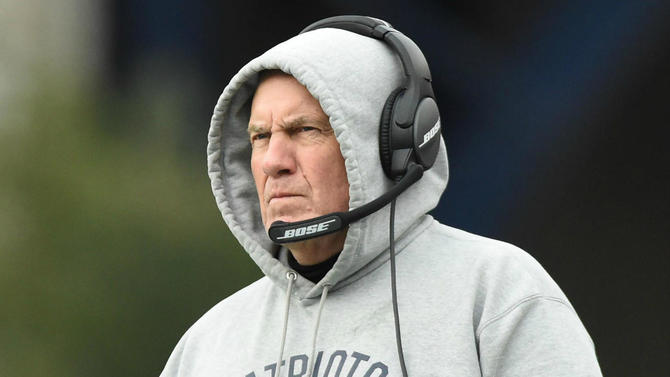
Coaching staff
Head coach: Bill Belichick (Patriots)
The greatest coach of all time, regardless of what happens with the Patriots now that Tom Brady has moved on. Belichick is the best defensive mind football has ever seen, and will come up with a creative new gameplan each week to shut down the opposing offense. He's not afraid to experiment with different kinds of fronts, send rushers from all different angles, and use all kinds of different coverages depending on the opponent. His preference for a gameplan-specific offense also works in our favor here, as we can deploy our versatile and dynamic personnel in all different kinds of alignments and roles on a week-to-week basis.
Also (briefly) considered: John Harbaugh, Kyle Shanahan
Offensive coordinator: Greg Roman (Ravens)
With Mahomes locked in at quarterback, Lamar Jackson was off the table as an option. That meant we had to go looking for another position at which to use a Raven. There are any number of good candidates and you'll see them all over the "also considered" lists below, but none served our purposes better than Roman. We have seen him find repeated success in designing offenses over the years, and he has never been afraid to experiment with different styles. Putting your quarterback in position to succeed is the most important thing you can do in the modern NFL, and no coordinator did a better job of that last season than Roman. We toyed with the idea of going with an Andy Reid-Josh McDaniels-Lamar Jackson combination, but this trio lent itself better to establishing a dominant pass game on both sides of the ball.
Also considered: Arthur Smith, Gary Kubiak, Kellen Moore
Defensive coordinator: Robert Saleh (49ers)
The best 49ers asset for this exercise was probably Kyle Shanahan. But with Belichick coaching the squad, again, we had to look elsewhere. We gave serious consideration to the likes of George Kittle, Nick Bosa, and Richard Sherman, among others, but Saleh's work with the San Francisco defense last season made for the best fit. His tweaks to the Seattle-style defense employed by the Niners, including a shift to more two-high coverages, gave us confidence that he'd be flexible enough to coach the kind of team we want to build. It also just felt nice to have the best overall coach in the league, the coordinator of the NFL's most efficient offense last season, and the coach whose defense would have been the best in the NFL last year if not for those pesky Patriots.
Also considered: Don Martindale, Jim Schwartz, Matt Eberflus
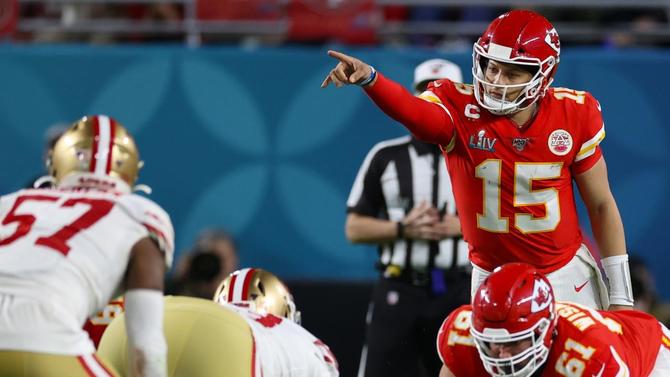
Offensive skill players
Quarterback: Patrick Mahomes (Chiefs)
Again, this man is the best quarterback in the NFL. He can make all the throws, including some that only exist inside his mind. He is capable under pressure and unstoppable from a clean pocket. He has a cannon arm, a quick release, and the necessary mobility to make things happen when the play breaks down. He strikes a fear into the defense that is unmatched around the league right now, and he has enough talent to go down as one of the greatest to ever play the game. In two seasons as a starter, he has an MVP and a Super Bowl, and he's not close to done. The guys on the list below are great players, but they are not Mahomes. They were never going to get this spot.
Also (briefly) considered: Lamar Jackson, Russell Wilson, Deshaun Watson
Running back: Christian McCaffrey (Panthers)
McCaffrey was not necessarily an obvious choice for this spot. We gave serious consideration to Saquon Barkley and Derrick Henry, among others, but the combination of McCaffrey's unrivaled passing-game contributions (where he has a big edge over Henry, who might be the best pure runner in the league) and the fact that it was incredibly difficult to find another capable representative for the Panthers on this roster ultimately tipped the scales in his direction. (That, and he is more consistent on a carry-to-carry basis than Barkley, who is a bit more dependent on splash plays and does not have as high a success rate on his runs.) We've seen what he can do with Cam Newton and Kyle Allen under center, with precious little talent around him elsewhere; imagine what he could do with Mahomes, who helped turn Damien Williams into one of the NFL's best pass-catching backs. And that's before we get to the work that run-game genius Greg Roman could do with a back who is already one of the most efficient high-volume runners in the league.
Also considered: Saquon Barkley, Derrick Henry, Ezekiel Elliott, Aaron Jones, Nick Chubb, Josh Jacobs, Chris Carson, Dalvin Cook, Austin Ekeler
Perimeter receivers: DeAndre Hopkins (Cardinals) and Mike Evans (Buccaneers)
Hopkins being traded to the Cardinals this offseason solved a few potential roster-construction issues, saving us the trouble of having to choose between him and the Texans' actual representative, who we'll get to later on. The way Houston used Hopkins last season was sub-optimal at best, but he still ended the year with 104 catches for 1,165 yards and seven scores, a trio of figures matched or exceeded by only one other player (Michael Thomas) last season.
You might want to take Chris Godwin over Mike Evans, but considering that Godwin ran nearly two-thirds of his routes from the slot last season, we can't justify that choice for this roster. Evans has the opposite splits, making him our choice for the outside guy here. Evans is also more of a deep threat than Godwin, which fits our purposes well given that Thomas and McCaffrey operate best in short areas and Hopkins is an intermediate-to-deep receiver. Giving Mahomes this type of threat on the outside should be fun.
Also considered: Stefon Diggs, Odell Beckham, Courtland Sutton, Amari Cooper, Tyler Lockett, A.J. Brown, Julio Jones
Slot receiver: Michael Thomas (Saints)
Thomas ran only 30 percent of his routes from the slot last season, per PFF, with his 179 slot routes ranking 39th in the NFL. And yet, he still managed to catch 52 passes (eighth-most in the league) for 601 yards (10th) and three scores (ninth) from that alignment. He also led the league in yards per route run from the slot (3.66) by nearly a full yard over the next closest player (Robert Woods). This was an absolute no-brainer.
Also (briefly) considered: Chris Godwin, JuJu Smith-Schuster, Keenan Allen, Cooper Kupp, Adam Thielen
Tight ends: Zach Ertz (Eagles) and Darren Waller (Raiders)
A pair of offensive linemen received serious consideration as the Eagles' representative, and so did a pair of defensive linemen. However, we settled on Ertz due to his combination of size and body control, which has helped make him one of the most consistent tight ends in the league over the past few seasons. With Kelce off the table, we took a hard look at George Kittle at tight end, but felt the overall roster was made better by using Saleh as our defensive coordinator and Ertz here.
Meanwhile, Waller was the fairly obvious choice for the Raiders. Tight end is not a particularly deep position, and he was one of the best in the NFL last season. Josh Jacobs is fine, but he was never going to be the top running back on our board. Maxx Crosby was on the list but never really a threat to make the roster as an edge rusher, and Lynn Bowden Jr. hasn't done any work as a returner at the NFL level yet, so we didn't feel comfortable taking him for that spot. So, Waller gets to be our second tight end for the occasions that we shift into 12 personnel.
Also considered: George Kittle, Austin Hooper, Mark Andrews, Hunter Henry
Flex player: Kenny Golladay (Lions)
After Darius Slay's trade to the Eagles, Golladay was really the only player that made all that much sense to take from the Lions. Luckily, part of this assignment included picking an extra "flex" offensive player who could be a wide receiver, running back, or tight end. So, Golladay it is.
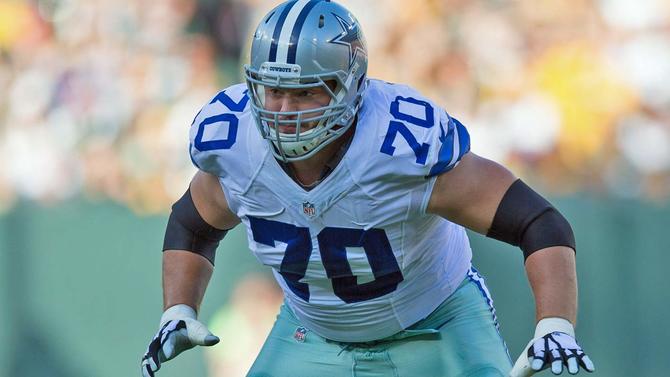
Offensive line
Left tackle: Jake Matthews (Falcons)
Is Matthews the best left tackle in the NFL? No. Is he the best player on the Falcons? Also no. But we're not just trying to pick the best player from each team here. We're trying to build the best roster we can, while using one -- and only one -- player or coach from each of the league's 32 teams. And Matthews is a really good player. Specifically, he is really good in pass protection. He has graded out 12th, fifth, and sixth among all tackles in pass-blocking grade over the past three seasons (minimum 500 snaps), per Pro Football Focus, and he has also taken a total of just 14 penalties during that time.
Also considered: Anthony Castonzo, David Bakhtiari, Alejandro Villanueva, Ronnie Stanley, Tyron Smith
Left guard: Quenton Nelson (Colts)
Nelson might very well be the best guard in the league. If it were not for the existence of the other guard on our team, I'd say that he definitely is the best. He's been in the NFL for two seasons and has been named to two Pro Bowls and two All-Pro teams, and all of those selections have been extraordinarily well-deserved. He is an absolute monster clearing the way in the run game, and he's also graded 12th and fifth among all guards in pass-blocking at PFF during his career. He's still just 24 years old, and there is no end to his dominance in sight.
Also considered: Joel Bitonio, Ali Marpet, Lane Taylor, Quinton Spain, Rodger Saffold
Center: Brandon Linder (Jaguars)
Finding a Jaguars representative was a little difficult at first, considering the talent exodus they've experienced over the past several seasons. Jalen Ramsey is gone, as is A.J. Bouye, and so are Calais Campbell and Malik Jackson and almost all of the other defenders who made their defense one of the best in the NFL. That left us to roll with Linder, who is one of the more underrated linemen in the NFL. He missed some time due to injury in 2015 and 2018, but in his four full seasons he has been terrific despite a paucity of talent around him. He also has the flexibility to play guard, which is nice for us if we want to mix things up a bit.
Also considered: Alex Mack, Matt Paradis, Connor McGovern
Right guard: Zack Martin (Cowboys)
Martin is the best overall player on the Cowboys. He has missed just two games in six seasons, and he has been named a Pro Bowler six times, a first-team All-Pro four times, and a second-team All-Pro twice. He is the best pass-blocking guard in the NFL (he's graded second, first, eight, fifth, sixth, and first at PFF during his career) and he is nearly as good at run-blocking as he is at pass-blocking. He was nearly as much of a lock for the roster as our four true must-haves.
Also considered: Kevin Zeitler, David DeCastro, Trai Turner, Brandon Scherff, Brandon Brooks
Right tackle: Jack Conklin (Browns)
Conklin just signed a huge deal with the Browns this offseason, and with good reason. He had his best season yet in 2019, bouncing back from a sub-par 2017 season and an injury-marred 2018 campaign. He cleared the way for a significant portion of Derrick Henry's league-high 1,540 rushing yards, with Henry averaging 5.99 yards per carry on runs to the gaps on either side of Conklin. There were versions of this roster where the Browns' representative was Myles Garrett or Odell Beckham, but using Conklin to solidify the right side of our line ended up being the best fit.
Also considered: Mike McGlinchey, Lane Johnson
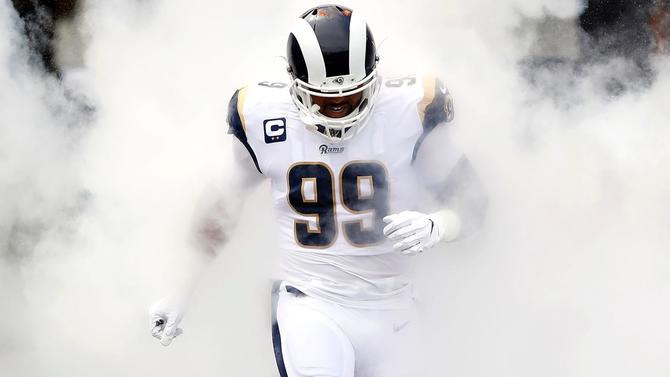
Defensive front
Edge rushers: Von Miller (Broncos) and Khalil Mack (Bears)
If Mack were still playing with the Raiders, we might have had to choose between these two players rather than taking them both. Miller rushes off the left side of the line of scrimmage a significant majority of the time -- he did so on 74.2 percent of his pass-rushing snaps last season, his lowest rate since 2013. In Mack's final three Raiders seasons, he rushed from the left 80.6, 62.8, and 79.5 percent of the time. Since arriving in Chicago, though, Mack has split his time almost equally between the left and right sides of the line of scrimmage; he had a 51.5-48.5 left-right split percentage in 2018 and a 50.4-49.6 split last year.
So, Miller is going to come off the left edge for us and Mack will come off the right. (And if we want to line them up on the same side of the line of scrimmage on occasion, well, we accounted for that with a few of our other picks for the defensive front.) Their resumes are pretty unimpeachable, plus Miller was a glaringly obvious choice for the Broncos' roster spot. There were other versions of the roster where Eddie Jackson (free safety), Eddie Goldman (nose tackle), Kyle Fuller (slot corner), or Cordarrelle Patterson (returner) were the Bears' rep and Chandler Jones, Za'Darius Smith, or Calais Campbell got the second edge spot, but we liked this version of the roster best.
Also considered: Chandler Jones, Za'Darius Smith, Calais Campbell, T.J. Watt, Myles Garrett, Brian Burns, Nick Bosa, Joey Bosa, Danielle Hunter, Josh Allen, Maxx Crosby, Arik Armstead, Chase Young
Interior defensive linemen: Aaron Donald (Rams) and J.J. Watt (Texans)
Donald has been in the NFL for six seasons. He's made six Pro Bowls and has appeared on the All-Pro first team five times. He was the Defensive Rookie of the Year and twice won the Defensive Player of the Year award. He made the 2010s All-Decade team. His 72 sacks are second-most in the NFL since he entered the league, and his 117 tackles for loss and 173 quarterback hits are both first. At PFF, he has been graded second, first, first, first, first, and first among interior defenders in his six seasons. He was the No. 1 player on our staff Top 100 last year and will likely be No. 2 at worst when we do the same list this year. It was impossible to make this team without him.
Watt was basically Donald before Donald was Donald. His ceiling is still just as high when he's fully healthy, but he's just not been able to maintain that health in recent years. He's only played more than eight games once in the past four seasons, but during that season (2018) he basically looked like 95 percent of the player he'd been before. With DeAndre Hopkins traded and Deshaun Watson making less sense for our roster than Patrick Mahomes, Watt made for an obvious Texans representative. His flexibility to rush from the edge in addition to the interior fits our schematic needs, and the fact that he has both Donald and the next player on our list around to soak up snaps will help us keep him healthy for a full season.
Also considered: Jurrell Casey, DeForest Buckner, Grady Jarrett, Larry Ogunjobi, Matt Ioannidis
Nose tackle: Kenny Clark (Packers)
In my opinion, Clark is perhaps the most underrated player in the league right now. He plays every position on the defensive interior for the Packers, splitting his time almost equally between operating as a nose tackle and a 3-4 end on either side of the center. He's a solid run defender, but he does his best work pushing the pocket as a pass rusher, notching six sacks in each of the past two seasons. Nose tackles don't really do that. When it came down to decision time, his ability to get after the quarterback is what put him over the top of the players we also considered for this spot.
Also considered: Brandon Williams, Danny Shelton, Eddie Goldman, D.J. Reader, Dalvin Tomlinson, Vita Vea
Flex LB: Kyle Van Noy (Dolphins)
Getting Van Noy onto this roster allows us to be really creative in how we line up defensively. The Patriots moved him all over the place in recent seasons. Though last year he operated almost exclusively on the edge, in 2018 he played 563 snaps as an edge defender and 514 as an inside linebacker. The year before, it was 380 on the edge and 468 inside. He has the versatility to move all over the place and is equally capable in both roles. Having one player who can come in and rush the passer, fill gaps against the run, or drop back into coverage is huge for our defense. We needed a player like this, and there just aren't many others like him.
Also considered: Jamie Collins, Isaiah Simmons
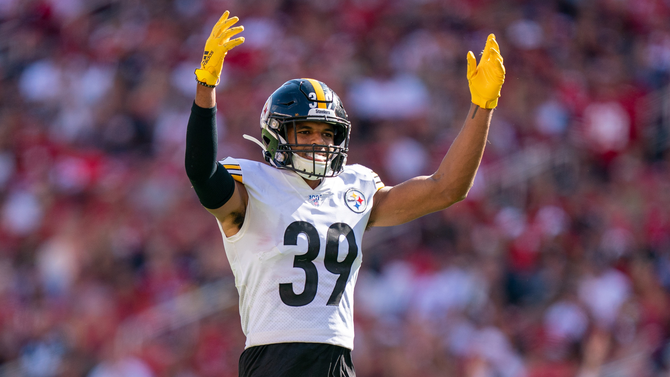
Back seven
Linebackers: Bobby Wagner (Seahawks) and Eric Kendricks (Vikings)
Wagner is a probable future Hall of Famer still playing at a high level deep into his career. He's been either the best or second-best middle linebacker in football for the majority of his career, and even though he's no longer necessarily at his peak, he is still among the very best in the game. He can flow sideline to sideline in the run game and remains among the league's best pass defenders at the linebacker spot.
Kendricks is following a similar career path to Wagner. He was finally, belatedly recognized with his first Pro Bowl and All-Pro selections last season, and at 28 years old he should have several more seasons of top-flight contributions in him. With these two players operating as our inside linebackers, we can feel confident in our ability to cover tight ends up the seam and running backs coming out of the backfield.
Also considered: C.J. Mosley, Roquan Smith, Dre Greenlaw, Cory Littleton, Myles Jack, Leighton Vander Esch
Outside corners: Tre'Davious White (Bills) and James Bradberry (Giants)
Once Stephon Gilmore was off the table as an option due to the selection of Belichick as our head coach, I knew that White was going to be our No. 1 corner. He's been one of the small handful of best players at his position since entering the league three years ago, but the 2019 season was his best yet. He allowed a passer rating of just 46.3 on throws in his direction, per PFF, the second-best mark among 99 players who spent at least 250 snaps in coverage. For his career, quarterbacks have a 62.0 rating when throwing at him. It's obscene how good he is.
Bradberry is moving to a new team, but his work in Carolina makes him a strong selection for the squad. He's spent the past few years shadowing the likes of Julio Jones, Mike Evans, and Michael Thomas twice a year each, and he's done extremely well in many of those matchups. He has great size, length, and speed and can work in a system where we shadow or play sides with our corners. With him and White on the outside, we can feel confident in sending extra rushers after the quarterback whenever we want.
Also considered: Byron Jones, Patrick Peterson, Casey Hayward, Darius Slay, Jaire Alexander, Marcus Peters, Joe Haden, Richard Sherman
Slot corner: Chris Harris Jr. (Chargers)
66.5, 64.9, 46.3, 89.0, 68.5, 76.6, 64.6. From 2012 through 2018, Harris spent the large majority of his snaps operating as a slot corner, and according to PFF, those were the year-by-year passer ratings opponents racked up on throws in his direction. The Broncos moved him to the perimeter last year, and he was not nearly as good. A move to the Chargers will have him back on the inside, where he is simply the best in the game.
Also considered: Marlon Humphrey, Kendall Fuller
Free safety: Minkah Fitzpatrick (Steelers)
Fitzpatrick claimed to not like being used as a versatile, Swiss Army knife type of player during his time in Miami. While the Steelers didn't move him around quite as much as the Dolphins, he did still drop into the box and bump into the slot fairly often, which makes him the perfect safety for the type of defense we want to run. His athleticism and knack for making plays on the ball all over the field should come in handy, especially given the pressure we expect our front to generate.
Also considered: Earl Thomas, Eddie Jackson, Derwin James, Kevin Byard
Box safety: Jamal Adams (Jets)
Adams, like Fitzpatrick, has a ton of flexibility and can operate in basically any role depending on what the defense needs on that given snap. Per PFF, he spent 401 snaps as a box safety last season, but also 297 as a free safety, 131 as a slot corner, 34 as a wide corner, and 96 as an edge defender. He excelled in each of those roles, and there's no reason to expect he wouldn't be able to do the same as part of this team -- especially given that he'd had significantly better talent around him than he has had during his time with the Jets.
Also considered: Landon Collins, Malcolm Jenkins, Harrison Smith
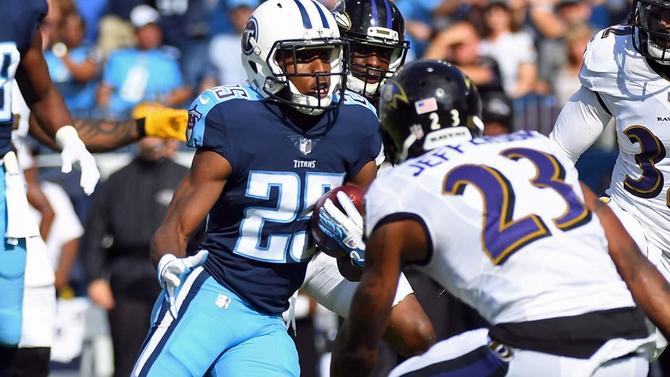
Specialists
Returner: Adoree' Jackson (Titans)
Jackson did not spend as much time as a return man last season as he had previously, but he's still a dynamic enough threat that the Titans would put him back there for important moments, and when he was their full-time return man he was one of the best in the NFL. He's got incredible speed and is a threat to score every time he makes just one man miss.
Also considered: Cordarrelle Patterson, Tony Pollard, Lynn Bowden Jr., Antonio Gibson
Punter: Tress Way (Washington)
Kicker: Randy Bullock (Bengals)
We chose these two guys because their teams did not have any representatives yet after the other 30 roster spots were filled.
Also considered: None









